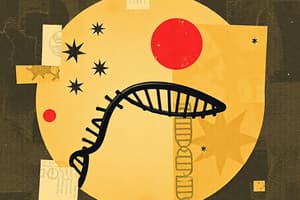Podcast
Questions and Answers
What process is responsible for producing RNA from a DNA template?
What process is responsible for producing RNA from a DNA template?
- Transcription (correct)
- Transformation
- Replication
- Translation
Which type of RNA has a base sequence that determines the order of amino acids in a protein?
Which type of RNA has a base sequence that determines the order of amino acids in a protein?
- tRNA
- mRNA (correct)
- rRNA
- snRNA
What modification occurs to eukaryotic mRNA before translation?
What modification occurs to eukaryotic mRNA before translation?
- Polymerization of amino acids
- Removal of exons and addition of a 3' cap
- Addition of a ribosomal binding site
- Splicing to remove introns and adding a poly-A tail (correct)
Why is a mutation in DNA considered more harmful than a transcription mistake?
Why is a mutation in DNA considered more harmful than a transcription mistake?
What is the significance of the 50S and 30S ribosomal subunits combining to form a 70S subunit?
What is the significance of the 50S and 30S ribosomal subunits combining to form a 70S subunit?
What happens to DNA when DNA gyrase cuts one part of a loop?
What happens to DNA when DNA gyrase cuts one part of a loop?
Why are adenine-guanine base pairs normally not found in DNA?
Why are adenine-guanine base pairs normally not found in DNA?
What is the reason for rejecting the proposal that phosphate groups could be at the center of a long DNA fiber?
What is the reason for rejecting the proposal that phosphate groups could be at the center of a long DNA fiber?
Why is it essential to specify that DNA is double-stranded when discussing base pairing?
Why is it essential to specify that DNA is double-stranded when discussing base pairing?
What is required for PCR to effectively replicate DNA?
What is required for PCR to effectively replicate DNA?
Why does DNA with a high A–T content have a lower transition temperature than DNA with a high G–C content?
Why does DNA with a high A–T content have a lower transition temperature than DNA with a high G–C content?
Which of the following are the primary types of RNA?
Which of the following are the primary types of RNA?
What determines the base sequence of all types of RNA?
What determines the base sequence of all types of RNA?
What is the complementary DNA sequence for the strand ACGTAT?
What is the complementary DNA sequence for the strand ACGTAT?
Which of the following is NOT a base found in RNA?
Which of the following is NOT a base found in RNA?
Which of the following statements about prokaryotic DNA is true?
Which of the following statements about prokaryotic DNA is true?
What characterizes B-DNA compared to Z-DNA?
What characterizes B-DNA compared to Z-DNA?
Which enzyme is responsible for relaxing supercoiled DNA?
Which enzyme is responsible for relaxing supercoiled DNA?
What describes the action of positive supercoiling in DNA?
What describes the action of positive supercoiling in DNA?
What does a propeller twist refer to in DNA structure?
What does a propeller twist refer to in DNA structure?
What is the main difference between the adenine-thymine and guanine-cytosine base pairs?
What is the main difference between the adenine-thymine and guanine-cytosine base pairs?
Flashcards
DNA Strand Complement
DNA Strand Complement
The sequence of a DNA strand that pairs with another strand according to the base-pairing rules (A with T, and G with C) read from 5' to 3' on the other strand.
RNA Bases
RNA Bases
RNA contains adenine, cytosine, guanine, and uracil. Modified bases also occur, especially in tRNA.
DNA Base Pairs
DNA Base Pairs
Adenine pairs with thymine (A-T); guanine pairs with cytosine (G-C).
Prokaryotic DNA
Prokaryotic DNA
Signup and view all the flashcards
DNA Supercoiling
DNA Supercoiling
Signup and view all the flashcards
Topoisomerase
Topoisomerase
Signup and view all the flashcards
B-DNA
B-DNA
Signup and view all the flashcards
Chromatin
Chromatin
Signup and view all the flashcards
Transcription
Transcription
Signup and view all the flashcards
tRNA Function
tRNA Function
Signup and view all the flashcards
mRNA role in protein synthesis
mRNA role in protein synthesis
Signup and view all the flashcards
Translation
Translation
Signup and view all the flashcards
Eukaryotic mRNA processing
Eukaryotic mRNA processing
Signup and view all the flashcards
DNA Gyrase Function
DNA Gyrase Function
Signup and view all the flashcards
DNA Phosphate Location
DNA Phosphate Location
Signup and view all the flashcards
DNA Base Composition
DNA Base Composition
Signup and view all the flashcards
PCR Primer Necessity
PCR Primer Necessity
Signup and view all the flashcards
High G-C Content in DNA
High G-C Content in DNA
Signup and view all the flashcards
Primary RNA Types
Primary RNA Types
Signup and view all the flashcards
RNA Base Sequence Determinant
RNA Base Sequence Determinant
Signup and view all the flashcards
Study Notes
DNA and RNA Structure and Function
- DNA sequences are read 5' to 3'
- DNA bases: Adenine (A), Cytosine (C), Guanine (G), Thymine (T)
- RNA bases: Adenine (A), Cytosine (C), Guanine (G), Uracil (U)
- DNA determines RNA sequence
- DNA sequences can be used to determine if it is DNA or RNA, based on the presence of thymine or uracil.
- RNA is usually involved in protein synthesis
- DNA and RNA have different base pair composition resulting in slightly different structures, and different functions in the body.
- DNA has a double helix structure, while RNA has a single strand
- A-T base pairs have two hydrogen bonds; G-C base pairs have three hydrogen bonds.
- Base pairs determine the shape and size of the DNA molecule (B-DNA, Z-DNA)
- DNA can exist in different conformations (e.g., B-DNA, Z-DNA) with differing spatial characteristics
- DNA can wrap around proteins forming chromatin
- Supercoiling occurs with both positive and negative twists
DNA Replication
- PCR (polymerase chain reaction) replicates DNA in forensic science.
- DNA replication requires a primer (DNA or RNA)
- Enzymes like DNA polymerase are needed for DNA replication.
DNA and RNA Differences
- DNA is double stranded and RNA is single-stranded.
- DNA uses thymine (T); RNA uses uracil (U).
- DNA stores genetic info; RNA primarily translates genetic info into protein
- DNA is usually found in the nucleus; RNA is found in the nucleus and cytoplasm of the cell.
Transcription and Translation
- Transcription converts DNA to mRNA.
- mRNA is translated to form amino acids which make up a protein.
- DNA errors during replication lead to incorrect DNA.
- Transcription errors lead to incorrect mRNA, which can impact protein formation.
- mRNA undergoes modifications, such as splicing, addition of a poly-A tail, and a 5' cap before translation.
- Incorrect mRNA may result from mistakes in transcription.
Ribosomes
- Ribosomes are formed by ribosomal subunits (50S and 30S).
- 50S and 30S subunits combine to form a 70S ribosome.
- Molecular weight, shape, and density of these components impact sedimentation.
Eukaryotic mRNA
- Eukaryotic mRNA undergoes modifications (splicing, poly-A tail, 5' cap) before translation, enhancing stability and proper translation.
- Eukaryotic mRNA modifications occur in the nucleus, and are then exported to the cytoplasm before translation.
Studying That Suits You
Use AI to generate personalized quizzes and flashcards to suit your learning preferences.




